Analyzing UK Private Rental Housing: Economics and Governmental Impact
VerifiedAdded on 2023/01/13
|14
|2967
|83
Report
AI Summary
This report provides an economic analysis of the UK private rental housing market. It begins by identifying the key factors determining the price of private rental housing in the UK, utilizing supply and demand analysis to explore the impact of economic growth, unemployment, interest rates, consumer confidence, mortgage availability, population changes, and renting costs. The report then delves into governmental and economic policies that can influence the demand for private rental housing, including planning policies, interest rate policies, flexibility in planning, incentives for local authorities, immigration, and measures to discourage buying-to-let properties. The analysis considers how these factors and policies interact to affect the supply and demand dynamics within the UK housing market, offering insights into the complexities of rental housing economics and the potential for policy interventions to shape market outcomes.

Economics for Business
Paraphrase This Document
Need a fresh take? Get an instant paraphrase of this document with our AI Paraphraser

Table of Contents
INTRODUCTION...........................................................................................................................3
Identifying main factors for determining price of the private rental housing in UK with use of
supply and the demand analysis..................................................................................................3
TASK 2..........................................................................................................................................11
Explaining and identifying major governmental and the economic policies which could be
utilised for influencing demand for the private rental housing within UK................................11
CONCLUSION..............................................................................................................................13
REFERENCES................................................................................................................................1
INTRODUCTION...........................................................................................................................3
Identifying main factors for determining price of the private rental housing in UK with use of
supply and the demand analysis..................................................................................................3
TASK 2..........................................................................................................................................11
Explaining and identifying major governmental and the economic policies which could be
utilised for influencing demand for the private rental housing within UK................................11
CONCLUSION..............................................................................................................................13
REFERENCES................................................................................................................................1
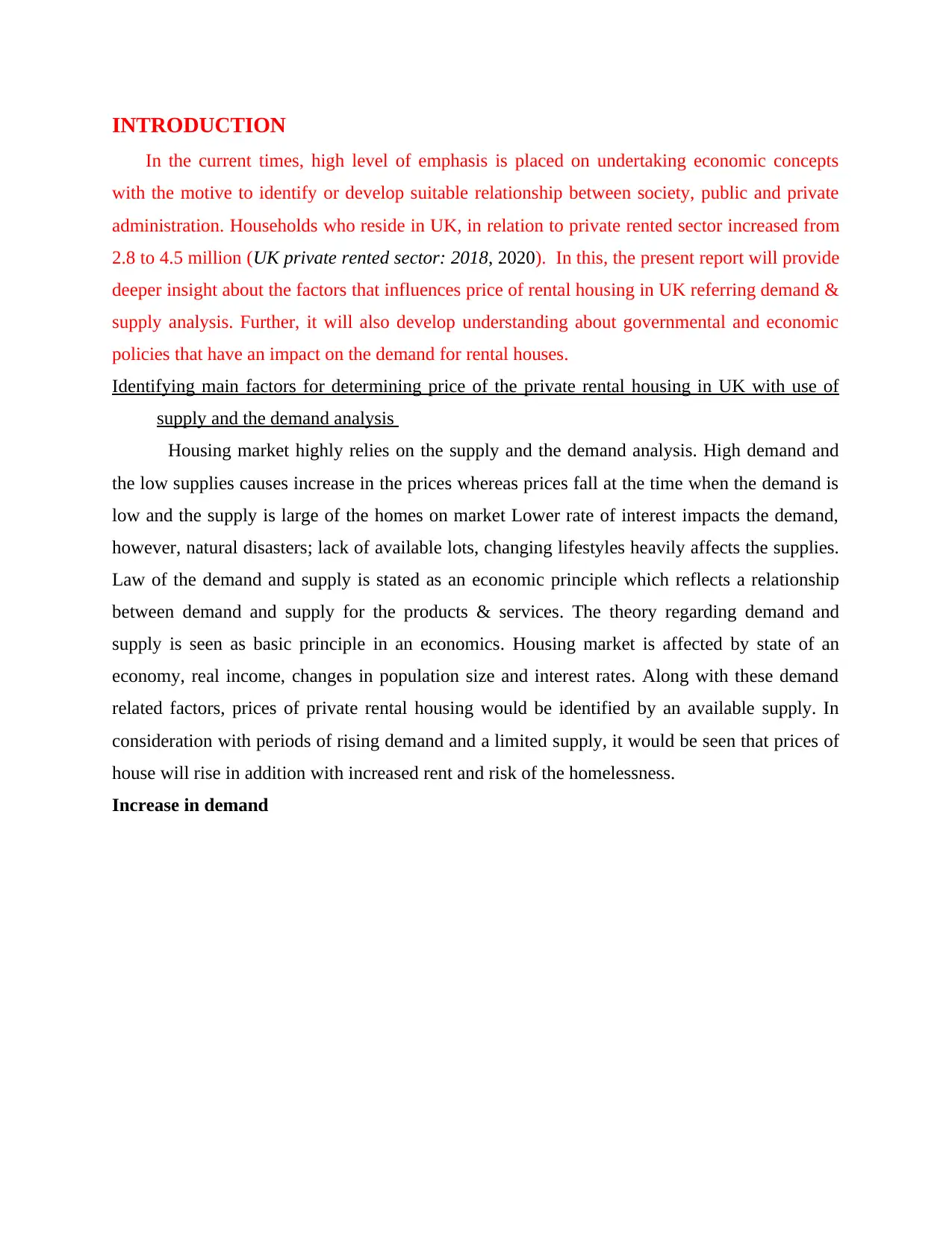
INTRODUCTION
In the current times, high level of emphasis is placed on undertaking economic concepts
with the motive to identify or develop suitable relationship between society, public and private
administration. Households who reside in UK, in relation to private rented sector increased from
2.8 to 4.5 million (UK private rented sector: 2018, 2020). In this, the present report will provide
deeper insight about the factors that influences price of rental housing in UK referring demand &
supply analysis. Further, it will also develop understanding about governmental and economic
policies that have an impact on the demand for rental houses.
Identifying main factors for determining price of the private rental housing in UK with use of
supply and the demand analysis
Housing market highly relies on the supply and the demand analysis. High demand and
the low supplies causes increase in the prices whereas prices fall at the time when the demand is
low and the supply is large of the homes on market Lower rate of interest impacts the demand,
however, natural disasters; lack of available lots, changing lifestyles heavily affects the supplies.
Law of the demand and supply is stated as an economic principle which reflects a relationship
between demand and supply for the products & services. The theory regarding demand and
supply is seen as basic principle in an economics. Housing market is affected by state of an
economy, real income, changes in population size and interest rates. Along with these demand
related factors, prices of private rental housing would be identified by an available supply. In
consideration with periods of rising demand and a limited supply, it would be seen that prices of
house will rise in addition with increased rent and risk of the homelessness.
Increase in demand
In the current times, high level of emphasis is placed on undertaking economic concepts
with the motive to identify or develop suitable relationship between society, public and private
administration. Households who reside in UK, in relation to private rented sector increased from
2.8 to 4.5 million (UK private rented sector: 2018, 2020). In this, the present report will provide
deeper insight about the factors that influences price of rental housing in UK referring demand &
supply analysis. Further, it will also develop understanding about governmental and economic
policies that have an impact on the demand for rental houses.
Identifying main factors for determining price of the private rental housing in UK with use of
supply and the demand analysis
Housing market highly relies on the supply and the demand analysis. High demand and
the low supplies causes increase in the prices whereas prices fall at the time when the demand is
low and the supply is large of the homes on market Lower rate of interest impacts the demand,
however, natural disasters; lack of available lots, changing lifestyles heavily affects the supplies.
Law of the demand and supply is stated as an economic principle which reflects a relationship
between demand and supply for the products & services. The theory regarding demand and
supply is seen as basic principle in an economics. Housing market is affected by state of an
economy, real income, changes in population size and interest rates. Along with these demand
related factors, prices of private rental housing would be identified by an available supply. In
consideration with periods of rising demand and a limited supply, it would be seen that prices of
house will rise in addition with increased rent and risk of the homelessness.
Increase in demand
⊘ This is a preview!⊘
Do you want full access?
Subscribe today to unlock all pages.

Trusted by 1+ million students worldwide

Paraphrase This Document
Need a fresh take? Get an instant paraphrase of this document with our AI Paraphraser

A shift in both supply & demand
Equilibrium
Equilibrium
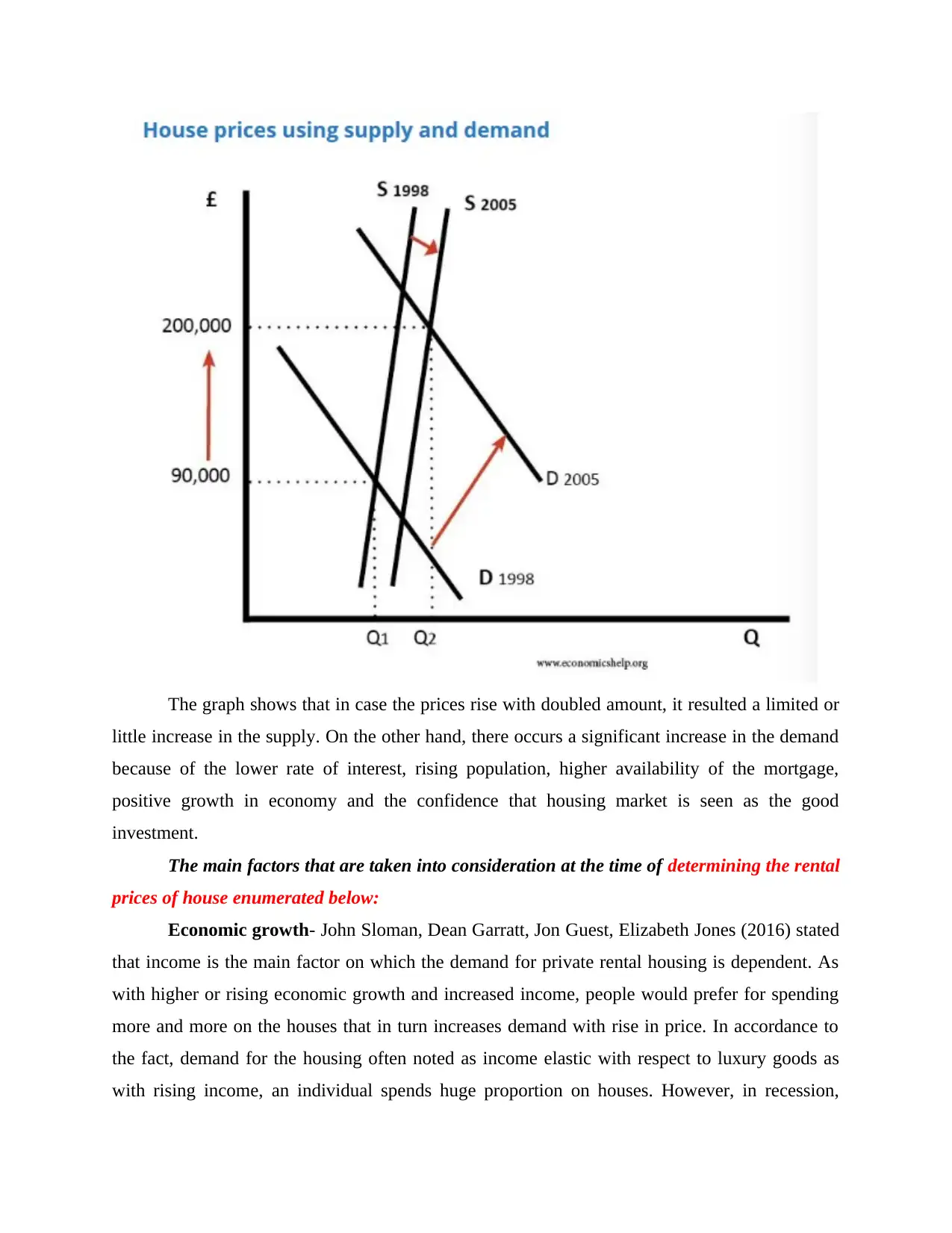
The graph shows that in case the prices rise with doubled amount, it resulted a limited or
little increase in the supply. On the other hand, there occurs a significant increase in the demand
because of the lower rate of interest, rising population, higher availability of the mortgage,
positive growth in economy and the confidence that housing market is seen as the good
investment.
The main factors that are taken into consideration at the time of determining the rental
prices of house enumerated below:
Economic growth- John Sloman, Dean Garratt, Jon Guest, Elizabeth Jones (2016) stated
that income is the main factor on which the demand for private rental housing is dependent. As
with higher or rising economic growth and increased income, people would prefer for spending
more and more on the houses that in turn increases demand with rise in price. In accordance to
the fact, demand for the housing often noted as income elastic with respect to luxury goods as
with rising income, an individual spends huge proportion on houses. However, in recession,
little increase in the supply. On the other hand, there occurs a significant increase in the demand
because of the lower rate of interest, rising population, higher availability of the mortgage,
positive growth in economy and the confidence that housing market is seen as the good
investment.
The main factors that are taken into consideration at the time of determining the rental
prices of house enumerated below:
Economic growth- John Sloman, Dean Garratt, Jon Guest, Elizabeth Jones (2016) stated
that income is the main factor on which the demand for private rental housing is dependent. As
with higher or rising economic growth and increased income, people would prefer for spending
more and more on the houses that in turn increases demand with rise in price. In accordance to
the fact, demand for the housing often noted as income elastic with respect to luxury goods as
with rising income, an individual spends huge proportion on houses. However, in recession,
⊘ This is a preview!⊘
Do you want full access?
Subscribe today to unlock all pages.

Trusted by 1+ million students worldwide

declining income depicts people cannot afford to purchase and with those who had lose their
respective jobs might fall behind their mortgage payments and in ending up with home
repossessed.
Unemployment- In relation to this factor, it has been stated that with rising
unemployment, very few people would able to afford for private rental property. Even fear
relating to unemployment might discourage the people from being entered into the property
market.
Interest rates- It is the factor that affects cost in relation to monthly mortgage payments.
High interest rate period would increase the cost relating to mortgage payments that results in
lower demand for purchasing the house. Higher rate of interest makes a renting more and more
attractive in comparison to buying. Rate of interest have bigger effect in case the homeowners
having large mortgage variables. For instance- in the year 1990-92, rise in the interest rate leads
to very steep decline in the prices of UK houses as many of the homeowners cannot afford rise or
increase in the interest rates.
Consumer confidence- It is an essential factor in determining preference of people in
relation to taking risk for mortgage. Particularly, expectation towards a housing market is seen as
crucial in case people fear that prices of the house could decline in future and this results to defer
buying.
Availability of Mortgage- In boom period that lies between 1996-2006, most of the
banks UK showed a keen interest in lending mortgages. Banks allowed the people in borrowing
huge income multiples that is four times income. Moreover, banks need very low amount of
deposits and this ease in getting mortgage meant as demand for the housing increases as higher
people will be able to buy it. On the other side, Parkin, Powell & Matthews (2015), since a credit
bunch resulted in 2007, building societies and the banks struggled in raising the funds for the
purpose of lending on money markets. Thus, banks had tightened the criteria for lending as
requiring huge deposits for purchasing or buying the house. This reduced an availability of the
mortgages and the demand for rental housing falls.
Population- It is the most critical factor as it just not reflects number of people but also
the demographic changes. For example- growing or increase in number of the single people who
lives alone led to increased demand for the houses.
respective jobs might fall behind their mortgage payments and in ending up with home
repossessed.
Unemployment- In relation to this factor, it has been stated that with rising
unemployment, very few people would able to afford for private rental property. Even fear
relating to unemployment might discourage the people from being entered into the property
market.
Interest rates- It is the factor that affects cost in relation to monthly mortgage payments.
High interest rate period would increase the cost relating to mortgage payments that results in
lower demand for purchasing the house. Higher rate of interest makes a renting more and more
attractive in comparison to buying. Rate of interest have bigger effect in case the homeowners
having large mortgage variables. For instance- in the year 1990-92, rise in the interest rate leads
to very steep decline in the prices of UK houses as many of the homeowners cannot afford rise or
increase in the interest rates.
Consumer confidence- It is an essential factor in determining preference of people in
relation to taking risk for mortgage. Particularly, expectation towards a housing market is seen as
crucial in case people fear that prices of the house could decline in future and this results to defer
buying.
Availability of Mortgage- In boom period that lies between 1996-2006, most of the
banks UK showed a keen interest in lending mortgages. Banks allowed the people in borrowing
huge income multiples that is four times income. Moreover, banks need very low amount of
deposits and this ease in getting mortgage meant as demand for the housing increases as higher
people will be able to buy it. On the other side, Parkin, Powell & Matthews (2015), since a credit
bunch resulted in 2007, building societies and the banks struggled in raising the funds for the
purpose of lending on money markets. Thus, banks had tightened the criteria for lending as
requiring huge deposits for purchasing or buying the house. This reduced an availability of the
mortgages and the demand for rental housing falls.
Population- It is the most critical factor as it just not reflects number of people but also
the demographic changes. For example- growing or increase in number of the single people who
lives alone led to increased demand for the houses.
Paraphrase This Document
Need a fresh take? Get an instant paraphrase of this document with our AI Paraphraser

Demand for rental housing not only depends on population but also on average household
size. Certain demographic and the social factors causing an increase in no. of households with a
faster pace than increase in population. Such demographic changes involve issues like age of the
people who are leaving home. Increased level of life expectancy results to more single old age
people and rising divorce rates leads to increasing number of the single parent family.
Renting cost- It has been seen that despite of the financial crisis and the housing crash,
cost of renting increases by 22% , this helped in causing rise in the UK house prices.
size. Certain demographic and the social factors causing an increase in no. of households with a
faster pace than increase in population. Such demographic changes involve issues like age of the
people who are leaving home. Increased level of life expectancy results to more single old age
people and rising divorce rates leads to increasing number of the single parent family.
Renting cost- It has been seen that despite of the financial crisis and the housing crash,
cost of renting increases by 22% , this helped in causing rise in the UK house prices.

The above graph shows that if renting cost increases, then the households would make a
greater effort in buying the house as purchasing the house by taking mortgage becomes as
relatively cheaper. The housing market of UK has been buoyed by an expensive cost of renting
that encourages buy for letting and encouraging lenders to stretch their respective budgets for
getting on housing ladder.
Affordability- Ratio regarding house prices to the earnings influences demand. As the
price of the house rises relating to an income, very few people would be expected to afford rent
of private house.
greater effort in buying the house as purchasing the house by taking mortgage becomes as
relatively cheaper. The housing market of UK has been buoyed by an expensive cost of renting
that encourages buy for letting and encouraging lenders to stretch their respective budgets for
getting on housing ladder.
Affordability- Ratio regarding house prices to the earnings influences demand. As the
price of the house rises relating to an income, very few people would be expected to afford rent
of private house.
⊘ This is a preview!⊘
Do you want full access?
Subscribe today to unlock all pages.

Trusted by 1+ million students worldwide
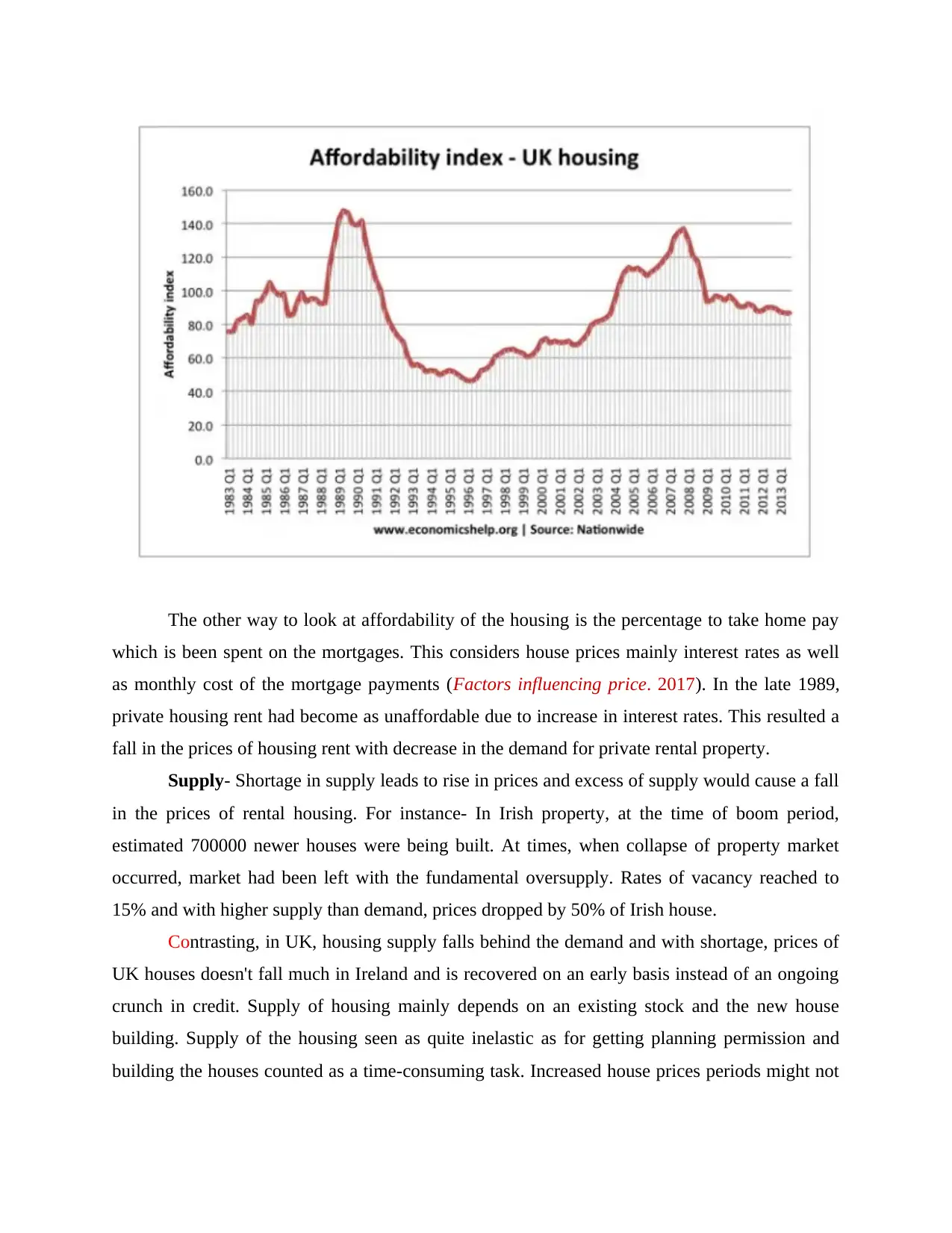
The other way to look at affordability of the housing is the percentage to take home pay
which is been spent on the mortgages. This considers house prices mainly interest rates as well
as monthly cost of the mortgage payments (Factors influencing price. 2017). In the late 1989,
private housing rent had become as unaffordable due to increase in interest rates. This resulted a
fall in the prices of housing rent with decrease in the demand for private rental property.
Supply- Shortage in supply leads to rise in prices and excess of supply would cause a fall
in the prices of rental housing. For instance- In Irish property, at the time of boom period,
estimated 700000 newer houses were being built. At times, when collapse of property market
occurred, market had been left with the fundamental oversupply. Rates of vacancy reached to
15% and with higher supply than demand, prices dropped by 50% of Irish house.
Contrasting, in UK, housing supply falls behind the demand and with shortage, prices of
UK houses doesn't fall much in Ireland and is recovered on an early basis instead of an ongoing
crunch in credit. Supply of housing mainly depends on an existing stock and the new house
building. Supply of the housing seen as quite inelastic as for getting planning permission and
building the houses counted as a time-consuming task. Increased house prices periods might not
which is been spent on the mortgages. This considers house prices mainly interest rates as well
as monthly cost of the mortgage payments (Factors influencing price. 2017). In the late 1989,
private housing rent had become as unaffordable due to increase in interest rates. This resulted a
fall in the prices of housing rent with decrease in the demand for private rental property.
Supply- Shortage in supply leads to rise in prices and excess of supply would cause a fall
in the prices of rental housing. For instance- In Irish property, at the time of boom period,
estimated 700000 newer houses were being built. At times, when collapse of property market
occurred, market had been left with the fundamental oversupply. Rates of vacancy reached to
15% and with higher supply than demand, prices dropped by 50% of Irish house.
Contrasting, in UK, housing supply falls behind the demand and with shortage, prices of
UK houses doesn't fall much in Ireland and is recovered on an early basis instead of an ongoing
crunch in credit. Supply of housing mainly depends on an existing stock and the new house
building. Supply of the housing seen as quite inelastic as for getting planning permission and
building the houses counted as a time-consuming task. Increased house prices periods might not
Paraphrase This Document
Need a fresh take? Get an instant paraphrase of this document with our AI Paraphraser
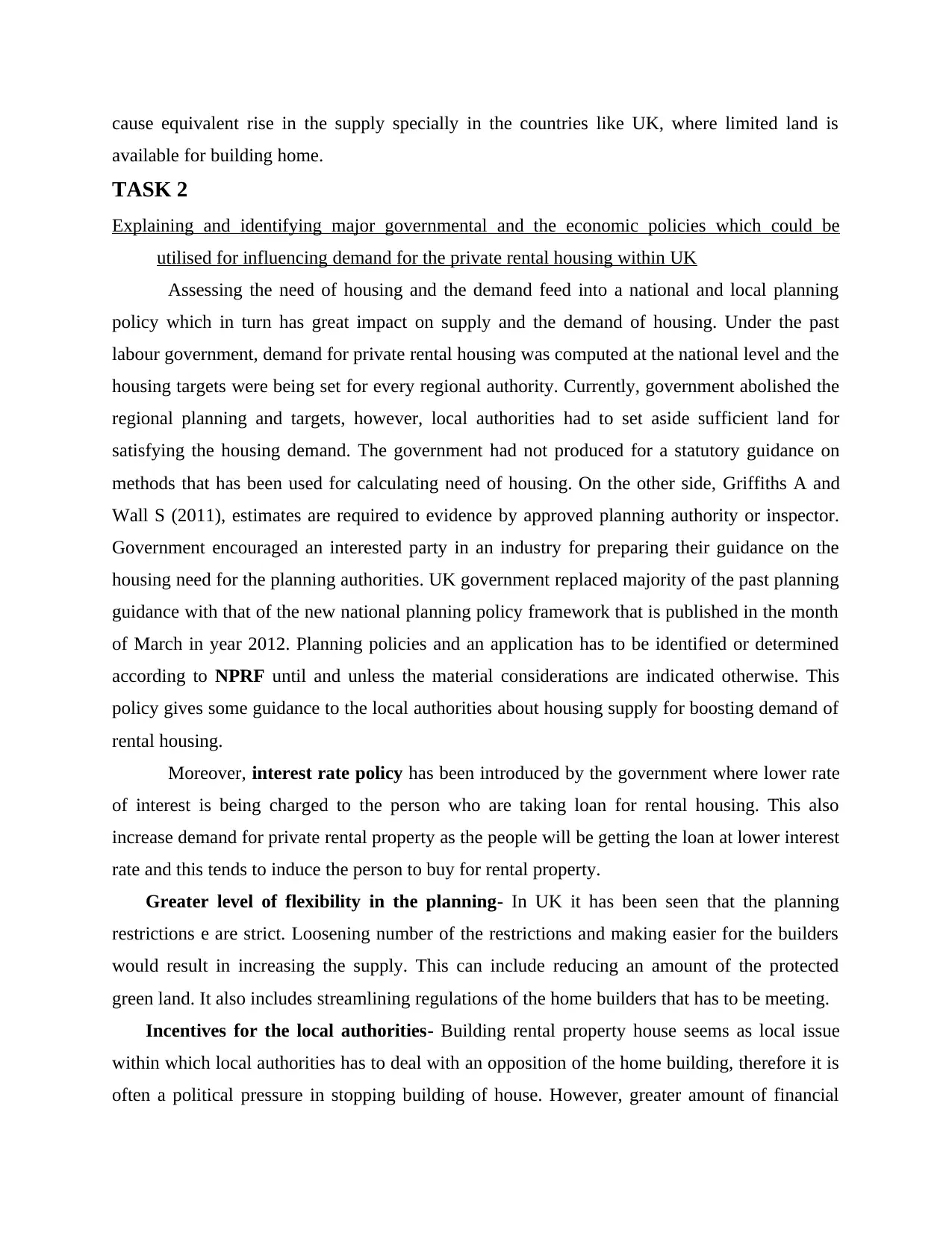
cause equivalent rise in the supply specially in the countries like UK, where limited land is
available for building home.
TASK 2
Explaining and identifying major governmental and the economic policies which could be
utilised for influencing demand for the private rental housing within UK
Assessing the need of housing and the demand feed into a national and local planning
policy which in turn has great impact on supply and the demand of housing. Under the past
labour government, demand for private rental housing was computed at the national level and the
housing targets were being set for every regional authority. Currently, government abolished the
regional planning and targets, however, local authorities had to set aside sufficient land for
satisfying the housing demand. The government had not produced for a statutory guidance on
methods that has been used for calculating need of housing. On the other side, Griffiths A and
Wall S (2011), estimates are required to evidence by approved planning authority or inspector.
Government encouraged an interested party in an industry for preparing their guidance on the
housing need for the planning authorities. UK government replaced majority of the past planning
guidance with that of the new national planning policy framework that is published in the month
of March in year 2012. Planning policies and an application has to be identified or determined
according to NPRF until and unless the material considerations are indicated otherwise. This
policy gives some guidance to the local authorities about housing supply for boosting demand of
rental housing.
Moreover, interest rate policy has been introduced by the government where lower rate
of interest is being charged to the person who are taking loan for rental housing. This also
increase demand for private rental property as the people will be getting the loan at lower interest
rate and this tends to induce the person to buy for rental property.
Greater level of flexibility in the planning- In UK it has been seen that the planning
restrictions e are strict. Loosening number of the restrictions and making easier for the builders
would result in increasing the supply. This can include reducing an amount of the protected
green land. It also includes streamlining regulations of the home builders that has to be meeting.
Incentives for the local authorities- Building rental property house seems as local issue
within which local authorities has to deal with an opposition of the home building, therefore it is
often a political pressure in stopping building of house. However, greater amount of financial
available for building home.
TASK 2
Explaining and identifying major governmental and the economic policies which could be
utilised for influencing demand for the private rental housing within UK
Assessing the need of housing and the demand feed into a national and local planning
policy which in turn has great impact on supply and the demand of housing. Under the past
labour government, demand for private rental housing was computed at the national level and the
housing targets were being set for every regional authority. Currently, government abolished the
regional planning and targets, however, local authorities had to set aside sufficient land for
satisfying the housing demand. The government had not produced for a statutory guidance on
methods that has been used for calculating need of housing. On the other side, Griffiths A and
Wall S (2011), estimates are required to evidence by approved planning authority or inspector.
Government encouraged an interested party in an industry for preparing their guidance on the
housing need for the planning authorities. UK government replaced majority of the past planning
guidance with that of the new national planning policy framework that is published in the month
of March in year 2012. Planning policies and an application has to be identified or determined
according to NPRF until and unless the material considerations are indicated otherwise. This
policy gives some guidance to the local authorities about housing supply for boosting demand of
rental housing.
Moreover, interest rate policy has been introduced by the government where lower rate
of interest is being charged to the person who are taking loan for rental housing. This also
increase demand for private rental property as the people will be getting the loan at lower interest
rate and this tends to induce the person to buy for rental property.
Greater level of flexibility in the planning- In UK it has been seen that the planning
restrictions e are strict. Loosening number of the restrictions and making easier for the builders
would result in increasing the supply. This can include reducing an amount of the protected
green land. It also includes streamlining regulations of the home builders that has to be meeting.
Incentives for the local authorities- Building rental property house seems as local issue
within which local authorities has to deal with an opposition of the home building, therefore it is
often a political pressure in stopping building of house. However, greater amount of financial
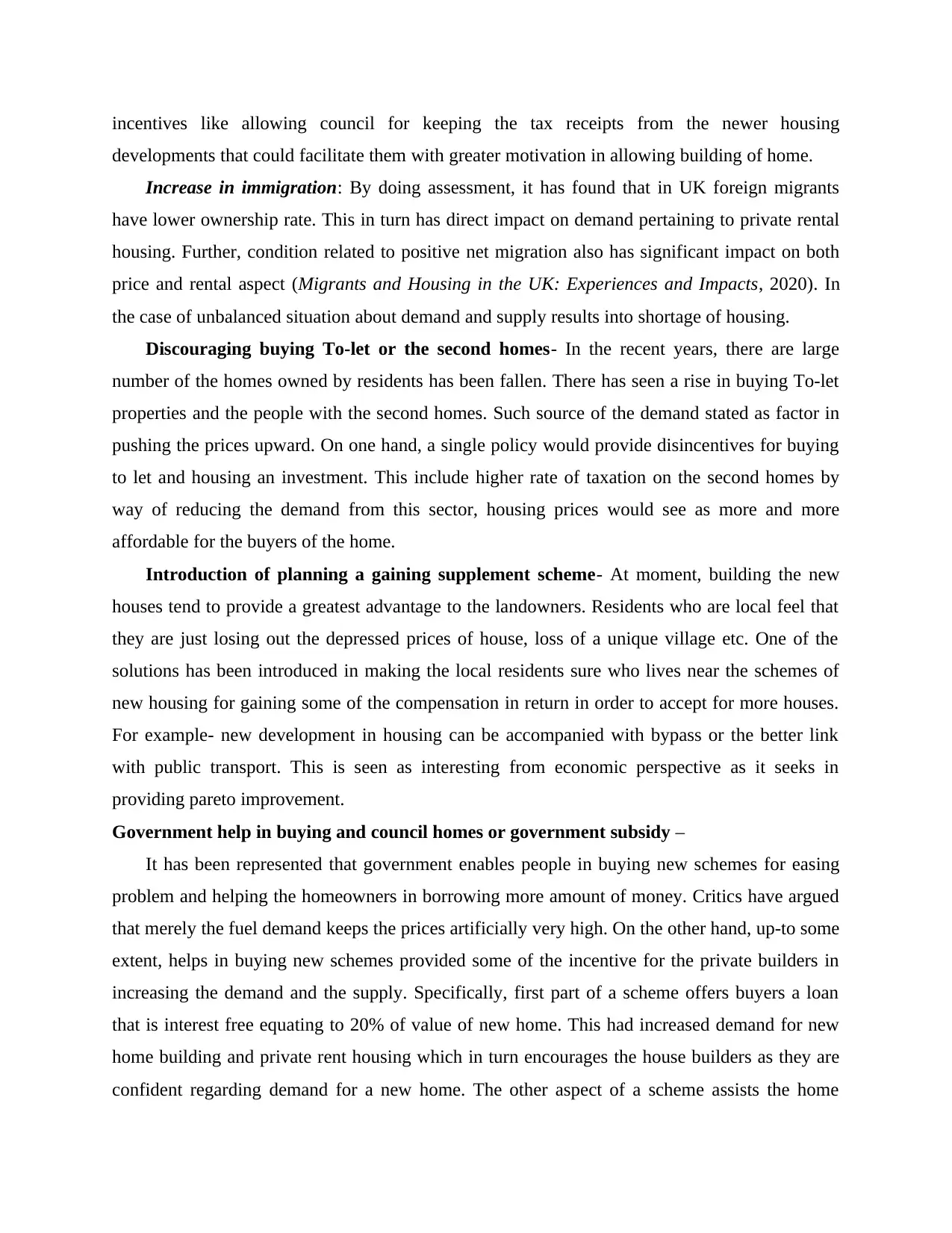
incentives like allowing council for keeping the tax receipts from the newer housing
developments that could facilitate them with greater motivation in allowing building of home.
Increase in immigration: By doing assessment, it has found that in UK foreign migrants
have lower ownership rate. This in turn has direct impact on demand pertaining to private rental
housing. Further, condition related to positive net migration also has significant impact on both
price and rental aspect (Migrants and Housing in the UK: Experiences and Impacts, 2020). In
the case of unbalanced situation about demand and supply results into shortage of housing.
Discouraging buying To-let or the second homes- In the recent years, there are large
number of the homes owned by residents has been fallen. There has seen a rise in buying To-let
properties and the people with the second homes. Such source of the demand stated as factor in
pushing the prices upward. On one hand, a single policy would provide disincentives for buying
to let and housing an investment. This include higher rate of taxation on the second homes by
way of reducing the demand from this sector, housing prices would see as more and more
affordable for the buyers of the home.
Introduction of planning a gaining supplement scheme- At moment, building the new
houses tend to provide a greatest advantage to the landowners. Residents who are local feel that
they are just losing out the depressed prices of house, loss of a unique village etc. One of the
solutions has been introduced in making the local residents sure who lives near the schemes of
new housing for gaining some of the compensation in return in order to accept for more houses.
For example- new development in housing can be accompanied with bypass or the better link
with public transport. This is seen as interesting from economic perspective as it seeks in
providing pareto improvement.
Government help in buying and council homes or government subsidy –
It has been represented that government enables people in buying new schemes for easing
problem and helping the homeowners in borrowing more amount of money. Critics have argued
that merely the fuel demand keeps the prices artificially very high. On the other hand, up-to some
extent, helps in buying new schemes provided some of the incentive for the private builders in
increasing the demand and the supply. Specifically, first part of a scheme offers buyers a loan
that is interest free equating to 20% of value of new home. This had increased demand for new
home building and private rent housing which in turn encourages the house builders as they are
confident regarding demand for a new home. The other aspect of a scheme assists the home
developments that could facilitate them with greater motivation in allowing building of home.
Increase in immigration: By doing assessment, it has found that in UK foreign migrants
have lower ownership rate. This in turn has direct impact on demand pertaining to private rental
housing. Further, condition related to positive net migration also has significant impact on both
price and rental aspect (Migrants and Housing in the UK: Experiences and Impacts, 2020). In
the case of unbalanced situation about demand and supply results into shortage of housing.
Discouraging buying To-let or the second homes- In the recent years, there are large
number of the homes owned by residents has been fallen. There has seen a rise in buying To-let
properties and the people with the second homes. Such source of the demand stated as factor in
pushing the prices upward. On one hand, a single policy would provide disincentives for buying
to let and housing an investment. This include higher rate of taxation on the second homes by
way of reducing the demand from this sector, housing prices would see as more and more
affordable for the buyers of the home.
Introduction of planning a gaining supplement scheme- At moment, building the new
houses tend to provide a greatest advantage to the landowners. Residents who are local feel that
they are just losing out the depressed prices of house, loss of a unique village etc. One of the
solutions has been introduced in making the local residents sure who lives near the schemes of
new housing for gaining some of the compensation in return in order to accept for more houses.
For example- new development in housing can be accompanied with bypass or the better link
with public transport. This is seen as interesting from economic perspective as it seeks in
providing pareto improvement.
Government help in buying and council homes or government subsidy –
It has been represented that government enables people in buying new schemes for easing
problem and helping the homeowners in borrowing more amount of money. Critics have argued
that merely the fuel demand keeps the prices artificially very high. On the other hand, up-to some
extent, helps in buying new schemes provided some of the incentive for the private builders in
increasing the demand and the supply. Specifically, first part of a scheme offers buyers a loan
that is interest free equating to 20% of value of new home. This had increased demand for new
home building and private rent housing which in turn encourages the house builders as they are
confident regarding demand for a new home. The other aspect of a scheme assists the home
⊘ This is a preview!⊘
Do you want full access?
Subscribe today to unlock all pages.

Trusted by 1+ million students worldwide
1 out of 14
Related Documents
Your All-in-One AI-Powered Toolkit for Academic Success.
+13062052269
info@desklib.com
Available 24*7 on WhatsApp / Email
![[object Object]](/_next/static/media/star-bottom.7253800d.svg)
Unlock your academic potential
Copyright © 2020–2025 A2Z Services. All Rights Reserved. Developed and managed by ZUCOL.





